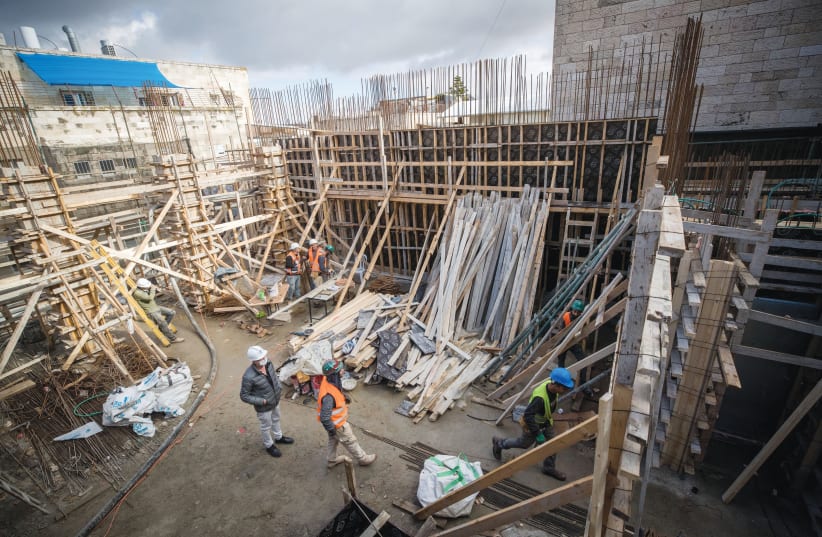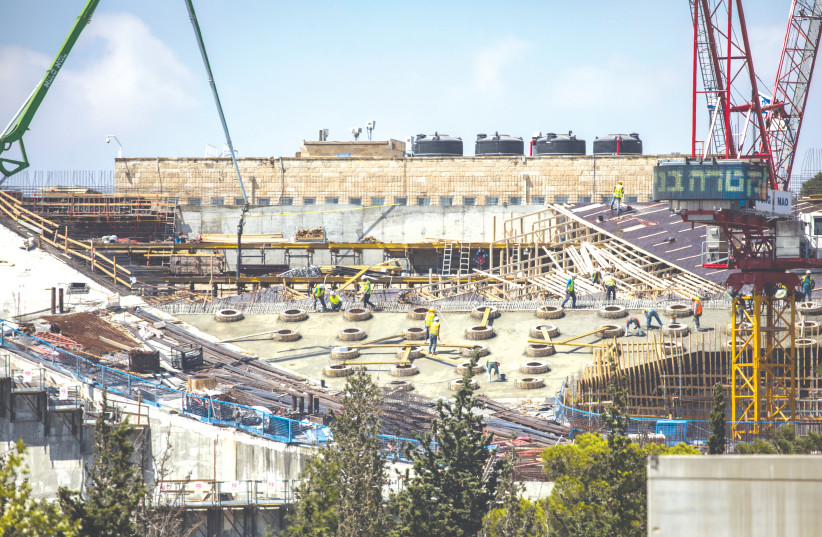Let’s build
It could be one explanation for the constantly rising cost of housing in Jerusalem: not enough housing units under construction. Yet on a national scale, Jerusalem is doing quite well. According to the Central Bureau of Statistics, while only 836 apartments began to be built in Jerusalem in the first half of 2021 – a rate considered a slowdown – Jerusalem is eighth among cities in the number of construction starts.
A quick glance at the size of the homes being built shows that 278 of the apartments are six-room units, 163 are five-rooms, 227 are four-rooms, and only 90 apartments have one to two rooms – which means that despite all the efforts made by city authorities, contractors are still not in the business of making affordable small apartments for singles or young couples.
According to Dror Ohev Zion, CEO of the real estate marketing company Dara, the supply of apartments in the capital in recent years is small in relation to the demand. “CBS data illustrate in numbers what we have been claiming for several years: that the new apartments being built in the city are through urban renewal only. The total number of apartments that will be produced from it in the next year or two won’t be large enough.”
Indeed, renewal projects take years to be completed, from the application for a permit to the completion of construction, contributing to the severe shortage of apartments in the city. According to Ohev Zion and many other contractors, the key to this situation is the hands of the municipality and the Housing Ministry.
Sad but necessary
The mobile clinic for the treatment of people in prostitution has arrived in Jerusalem, after unclear reasons prevented its arrival for several years, and last week finally began operating. It is important to note that all services are provided free of charge and anonymously. The project allows those who have been in the world of prostitution, from all genders and sectors, to be tested for sexually transmitted diseases and HIV/AIDS and to receive medication for infections.
In addition, according to the Health Ministry, the mobile clinic staff provides primary medical assistance, information and counseling on health and welfare issues, and directs those who are interested in additional counseling, treatment and rehabilitation.
A team of social workers provide psychosocial care both in exercising medical and social rights and in trauma recovery. The branch of this service is operated by the municipality’s Welfare Department, which is responsible for staff recruitment and building treatment plans while creating connections with relevant city partners.
Tel. (02) 657-8686. Hours of operation of the phone answering service: Sunday-Wednesday from 8 a.m.-3 p.m.; and Thursdays from 8 a.m.-2 p.m. and 5-10 p.m.
On such a cloudy day
American software company Oracle announced the opening of an underground cloud area to expand secure cloud services in Israel on Har Hotzvim. The new cloud, located in the basement of the Rad Bynet Tower, will offer all of Oracle’s cloud services, like the Oracle Autonomous Database, Kubernetes services and Oracle’s cloud applications, Oracle Fusion Cloud Applications.
Oracle’s new underground cloud area in Jerusalem will allow organizations and government agencies to make a rapid transition to the cloud, and the fact that this is taking place in Jerusalem points at the facilities the capital can offer.
Our beautiful city
The municipality is investing a lot of resources in improving public spaces, mainly through grants to improve the facades of buildings and shop windows of businesses in the city center. However, the response is relatively low. And, according to Dr. Ofir Lang, chairman of the Lev Ha’ir local council, it requires a rethink regarding the local authority’s involvement in initiating a horizontal project to improve the visibility of buildings so as to encourage the city’s strolling experience.
The answer could come from the city’s Law for Maintaining Order and Cleanliness, which could set out guidelines for the preservation and improvement of facades, and even gives the municipality the right to carry out the restoration of facades and then collect the expenses from property owners.
So far, the use of this law hasn’t been widespread, but Lang proposes that if communities work toward reaching an agreement with apartment owners and businesses, accompanied by municipal budget assistance, it will be possible to promote the renovation of many city building facades.
Who by fire, who by plague
Data collected by the Health Ministry and the municipality provide a picture of the spread of the coronavirus and its death toll for each sector and neighborhood. Of the approximately 7,900 people (data from October 10) who died since the pandemic outbreak, 970 are from Jerusalem. About a third of those are from the general sector, close to a third are from the city’s east side and a little more than a quarter are from the haredi sector.
Through a monitoring and control system for coronavirus patients, developed in the Computer and Information Systems Division, the municipality could rapidly get a clear picture of the situation across the city at any given moment. The system, which won a prestigious municipal award, presented in real time the distribution of patients and isolated residents in all the city’s neighborhoods and made it possible to provide dedicated assistance to areas where there was an outbreak.
One of the system’s recent findings was that the fourth wave mainly hit in the east side of the city and from there spread to the ultra-Orthodox sector. According to the Jerusalem Education Administration (Manhi), as of last week, 481 students from the east side, 331 in the haredi sector and 241 in the general sector were found to be infected.
As for the death toll, 44 people died in Kiryat Yovel, 38 in the Old City, 37 in A-Tur, 31 in Bayit Vagan, 29 in Gilo, 28 in Geula and in Jebl Mukaber, 27 in Gonenim and in Beit Hanina and 25 in Shuafat. Twenty-three people died in Romema-Tel Arza, 22 in Beit Hakerem and 22 also in Har Homa, 21 in Neveh Ya’acov. Twenty Jerusalemites died of the virus in the neighborhoods of Har Nof, Nahlaot, Wadi Joz-Sheikh Jarrah and Ras el-Amud. In Kfar Akev (beyond the fence) 19 died, 18 in Ramot, 17 in Talpiot and also 17 in Shuafat. In Old Katamon 16 died, in the Bukharan Quarter 15, in Mea She’arim, and in Givat Shaul, Sur Bahir and Beit Safafa each 13 people died.
It turns out, according to these findings, that the percentage of vaccinated residents is lower than the national average. As of October 10, only 22% of Jerusalemites received a third dose, compared with 48% in Tel Aviv and 44% in Haifa.
Yet in the capital there are more children under the age of 12, who as of yet cannot be vaccinated. The municipality says it analyzed the number of vaccinated people from the vaccine target population. And here the picture is different: From the Arab sector 38% have received a third jab, in haredi neighborhoods 62%, and in the general sector 78%.
Another finding shows that many of Jerusalem’s dead in the fourth wave were from the Arab sector, where the percentage of vaccinated is relatively low. As for the list of neighborhoods where the most COVID-19 patients needed hospitalization since the beginning of the pandemic, they are in descending order: Beit Hanina, the Old City, A-Tur, Pisgat Ze’ev, Ramot, Kfar Akev, Jebl Mukaber and Gilo.

